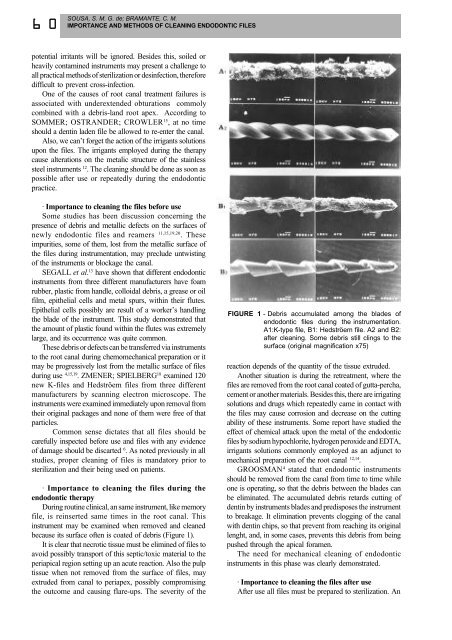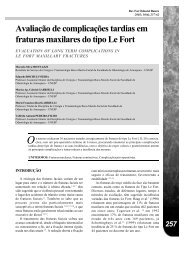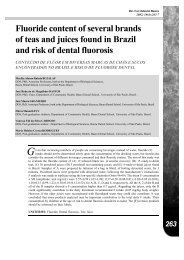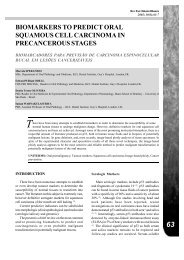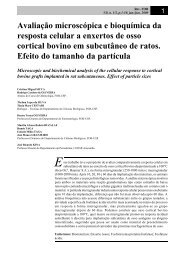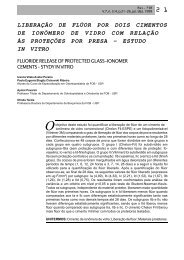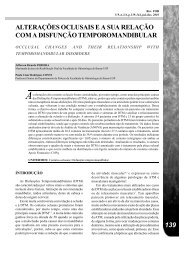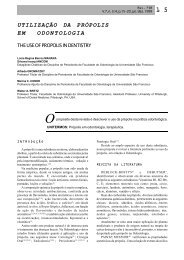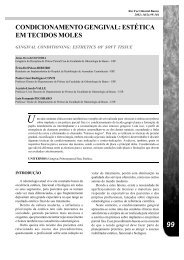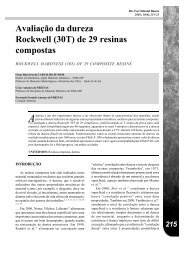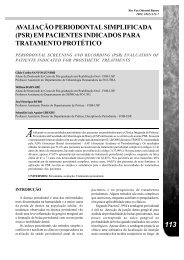IMPORTANCE AND METHODS OF CLEANING ENDODONTIC FILES
IMPORTANCE AND METHODS OF CLEANING ENDODONTIC FILES
IMPORTANCE AND METHODS OF CLEANING ENDODONTIC FILES
Create successful ePaper yourself
Turn your PDF publications into a flip-book with our unique Google optimized e-Paper software.
60<br />
SOUSA, S. M. G. de; BRAMANTE, C. M.<br />
<strong>IMPORTANCE</strong> <strong>AND</strong> <strong>METHODS</strong> <strong>OF</strong> <strong>CLEANING</strong> <strong>ENDODONTIC</strong> <strong>FILES</strong><br />
potential irritants will be ignored. Besides this, soiled or<br />
heavily contamined instruments may present a challenge to<br />
all practical methods of sterilization or desinfection, therefore<br />
difficult to prevent cross-infection.<br />
One of the causes of root canal treatment failures is<br />
associated with underextended obturations commoly<br />
combined with a debris-land root apex. According to<br />
SOMMER; OSTR<strong>AND</strong>ER; CROWLER 15 , at no time<br />
should a dentin laden file be allowed to re-enter the canal.<br />
Also, we can’t forget the action of the irrigants solutions<br />
upon the files. The irrigants employed during the therapy<br />
cause alterations on the metalic structure of the stainless<br />
steel instruments 12 . The cleaning should be done as soon as<br />
possible after use or repeatedly during the endodontic<br />
practice.<br />
· Importance to cleaning the files before use<br />
Some studies has been discussion concerning the<br />
presence of debris and metallic defects on the surfaces of<br />
newly endodontic files and reamers 11,15,19,20 . These<br />
impurities, some of them, lost from the metallic surface of<br />
the files during instrumentation, may preclude untwisting<br />
of the instruments or blockage the canal.<br />
SEGALL et al. 13 have shown that different endodontic<br />
instruments from three different manufacturers have foam<br />
rubber, plastic from handle, colloidal debris, a grease or oil<br />
film, epithelial cells and metal spurs, within their flutes.<br />
Epithelial cells possibly are result of a worker’s handling<br />
the blade of the instrument. This study demonstrated that<br />
the amount of plastic found within the flutes was extremely<br />
large, and its occurrrence was quite common.<br />
These debris or defects can be transferred via instruments<br />
to the root canal during chemomechanical preparation or it<br />
may be progressively lost from the metallic surface of files<br />
during use 4,15,19 . ZMENER; SPIELBERG 18 examined 120<br />
new K-files and Hedströem files from three different<br />
manufacturers by scanning electron microscope. The<br />
instruments were examined immediately upon removal from<br />
their original packages and none of them were free of that<br />
particles.<br />
Common sense dictates that all files should be<br />
carefully inspected before use and files with any evidence<br />
of damage should be discarted 6 . As noted previously in all<br />
studies, proper cleaning of files is mandatory prior to<br />
sterilization and their being used on patients.<br />
· Importance to cleaning the files during the<br />
endodontic therapy<br />
During routine clinical, an same instrument, like memory<br />
file, is reinserted same times in the root canal. This<br />
instrument may be examined when removed and cleaned<br />
because its surface often is coated of debris (Figure 1).<br />
It is clear that necrotic tissue must be elimined of files to<br />
avoid possibly transport of this septic/toxic material to the<br />
periapical region setting up an acute reaction. Also the pulp<br />
tissue when not removed from the surface of files, may<br />
extruded from canal to periapex, possibly compromising<br />
the outcome and causing flare-ups. The severity of the<br />
FIGURE 1 - Debris accumulated among the blades of<br />
endodontic files during the instrumentation.<br />
A1:K-type file, B1: Hedströem file. A2 and B2:<br />
after cleaning. Some debris still clings to the<br />
surface (original magnification x75)<br />
reaction depends of the quantity of the tissue extruded.<br />
Another situation is during the retreatment, where the<br />
files are removed from the root canal coated of gutta-percha,<br />
cement or another materials. Besides this, there are irrigating<br />
solutions and drugs which repeatedly came in contact with<br />
the files may cause corrosion and decrease on the cutting<br />
ability of these instruments. Some report have studied the<br />
effect of chemical attack upon the metal of the endodontic<br />
files by sodium hypochlorite, hydrogen peroxide and EDTA,<br />
irrigants solutions commonly employed as an adjunct to<br />
mechanical preparation of the root canal 12,14 .<br />
GROOSMAN 4 stated that endodontic instruments<br />
should be removed from the canal from time to time while<br />
one is operating, so that the debris between the blades can<br />
be eliminated. The accumulated debris retards cutting of<br />
dentin by instruments blades and predisposes the instrument<br />
to breakage. It elimination prevents clogging of the canal<br />
with dentin chips, so that prevent from reaching its original<br />
lenght, and, in some cases, prevents this debris from being<br />
pushed through the apical foramen.<br />
The need for mechanical cleaning of endodontic<br />
instruments in this phase was clearly demonstrated.<br />
· Importance to cleaning the files after use<br />
After use all files must be prepared to sterilization. An


